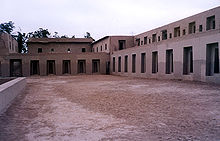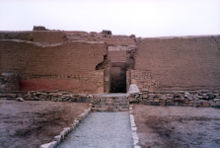Pachacámac
The ancient city of Pachacámac ( Quechua : Pachakamaq after the creator god of the same name) is an archaeological site about 40 km southeast of the city center of Lima in Peru , on the valley of the Río Lurín river . One of the first excavators in the city was the German archaeologist Max Uhle , to whom a memorial stone is dedicated here.
history
The city was already well over a thousand years old at the time of the Conquista . It had at least one pyramid, a cemetery and colorful fish frescoes from around 200–600 AD. Under the Wari culture (around 600–800 AD), the city was expanded and probably served as a Administrative center. Wari influences can be found on the architecture as well as on ceramics and textiles (grave goods). After the collapse of the Wari Empire, Pachakamaq continued to grow and became the center of an empire that never reached the dimensions of the Wari Empire. Most of the temples and simple buildings date from this period (approx. 800–1450 AD).
The Pachakamaq empire was probably already disintegrated by the arrival of the Incas . In the valleys of the Río Rímac and Río Lurín, the Ichma people had a small empire. The city of Pachakamaq served them primarily as a religious center for the worship of the creator god Pachakamaq. After the Ichma were incorporated into the Inca Empire, the city of Pachakamaq became an important administrative center. At the same time, however, it remained a temple city, and the priests of Pachakamaq were allowed to continue working independently of the Inca priesthood. The Incas themselves probably consulted the oracle of Pachakamaq regularly . Five buildings date from the time of the Incas, including the Sun Temple on the main square.
Location of the place in today's Peru
The archaeological site of Pachacámac is located in the north of the coastal district of Lurín , just under 2 kilometers from the sea. The ruin complex lies on a natural elevation on the southern edge of the densely populated urban area of Lima. A neighboring district of Lurín in the east also bears the name Pachacámac and claims the site and the adjacent settlement Julio C. Tello (also known as Puente Lurín ) as part of its territory.
The surrounding population is growing rapidly due to immigration into the valley of the Lurín River, but the surrounding area is still strongly characterized by agriculture (irrigation culture).
Attractions
The oracle was built from adobe bricks (adobes) before the Inca period. The part of Pachakamaq built by the Incas is practically completely preserved, especially the area built between the years 1440 and 1533 . You can visit palaces, temples, squares and the museum, where archaeological finds from Pachakamaq are kept.
The main buildings are:
- Sun temple
- Moon Temple (restored by Julio César Tello , also: "Temple of the Sun Maiden ", called Mamakuna or Mamaconas )
- Pachakamaq Temple (only preserved as a ruin)
- Urpi Wachaq Temple
- Pilgrimage place
The various areas of the ruins can be visited on foot or by vehicles (tourist buses or private vehicles) on a set route.
Web links
Coordinates: 12 ° 15 ′ S , 76 ° 54 ′ W


